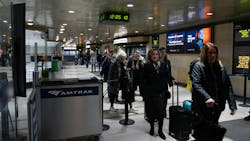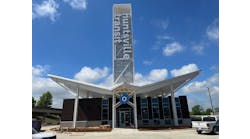Plans to overhaul Chicago Union Station are moving forward, as officials look to modernize and boost capacity at a key hub for Metra commuter trains and Amtrak.
The aging station, last renovated in 1991, is in line to get nearly $134 million in federal funding for the project so far. Though the funding is still short of what Amtrak, which owns Union Station, at one point sought for work at and around the downtown Chicago train depot, design work is moving forward.
The project is expected to include overhauling the concourse to improve the way passengers move through the area, renovating and expanding station platforms — including those on the south concourse used primarily by Metra’s BNSF line — and bringing platforms into compliance with the Americans with Disabilities Act.
Amtrak also hopes to rehab old, unused platforms that once served trains carrying U.S. Postal Service mail, now littered with the remnants of decaying booths and unneeded station infrastructure, and the tracks alongside used to store trains. Returning the platforms to service would expand the station’s train capacity.
Specifics of what the redesign will look like are still being determined, but one goal is to clear out the “mazelike interior” of the station concourses, Amtrak spokesperson Marc Magliari said. The concourse design work is led by FXCollaborative and Epstein, a Chicago-based firm.
When the station was last renovated in 1991, Amtrak’s annual passenger count at the station was 2.3 million and Metra’s was 26.6 million, according to information provided by Amtrak. In 2019, Union Station served 3.3 million Amtrak riders and 32.6 million Metra passengers, according to Amtrak’s data, though ridership on both services has dropped since then, with Metra ridership across all lines at about 51% of 2019 levels on weekdays in 2023, and Amtrak serving 2.7 million passengers at Union Station.
Amtrak was awarded up to $93.6 million in federal grants in December for the project and is in line for another $40 million for Union Station in the federal budget. Still, in an earlier 2022 grant application, Amtrak sought $251 million for the project, which at the time was expected to cover more than half the cost of construction.
Magliari said the estimated costs at that time included track construction outside the station intended to shorten the running time of some trains and reshuffle the tracks on which they run. The passenger rail service is seeking more money for work both at Union Station and for the tracks connecting to it, Magliari said. He declined to specify how much more funding could be needed for the station, saying the total cost will depend on the design work that is underway.
One piece of the project is intended to free up space in the concourses. Old ticket windows that are no longer used have been covered over with drywall, which could be torn down and gutted to create more room for passengers to move about the station, Magliari said. Escalators are also an area of focus, and can be improved to accommodate more passengers, he said.
Much of the station design dates back to the 1991 overhaul of the station. Mark Walbrun, who oversaw that project for Amtrak, said the renovation was only intended to create enough capacity at the station for the next 15 years.
At the time, Amtrak was running out of room for passengers at Union Station, and Metra, still a relatively new service, was trying to shoehorn its operations into facilities that had been designed for multiple different passenger railroads, Walbrun said. The concourses were peppered with columns needed to support the building that had been constructed above.
The 1991 renovation left what is now the Great Hall largely without a designated purpose, and relatively disconnected from the concourses and train operations to the east. At the time a marketplace was planned for the space, but it never materialized, Walbrun said.
The newest project won’t be without challenges, he said. The columns supporting the building above remain obstacles, and utilities and elevator shafts lurk behind drywall and will need to be addressed to create some of the open spaces Amtrak envisions.
But the station is well beyond the intended 15-year lifespan of the last renovation, Walbrun said. When trains are delayed or canceled, there are few places that can accommodate waiting passengers. Waiting areas closer to the train gates are needed, and limited capacity on the station’s escalators is particularly an issue, he said.
“It’s basically a space situation,” he said. “Particularly in the eastern side of the station.”
©2024 Chicago Tribune. Visit chicagotribune.com. Distributed by Tribune Content Agency, LLC.



